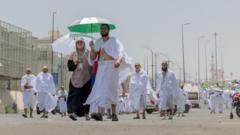In an effort to safeguard the health and well-being of the over 1.4 million Muslims participating in this year's Hajj pilgrimage, Saudi officials are rolling out stringent safety measures due to anticipated extreme heat conditions. Last year’s pilgrimage saw a devastating loss of 1,300 lives, mainly attributed to the scorching temperatures, prompting authorities to take action.
This year's Hajj commenced in Mecca amidst forecasts of temperatures soaring to 44°C (111°F). To counter these, officials have implemented several initiatives, including the planting of thousands of trees and the installation of over 400 cooling units within pilgrim areas. Significant fines are being imposed on individuals attempting the pilgrimage without proper authorization, with more than 269,000 people already prevented from entering the holy city of Mecca.
Most of last year's fatalities were linked to unregistered pilgrims who lacked access to necessary amenities such as air conditioning and transport. To ensure a more controlled environment, Saudi Arabia has introduced measures to discourage unauthorized visitors, reminding pilgrims that fines may reach $5,000 and entry bans could last up to a decade.
As an integral component of Islam, the Hajj—one of the five sacred Pillars—takes place annually, and all adult Muslims are expected to undertake this pilgrimage at least once if financially and physically able. Pilgrims engage in essential rituals, including the tawaf, where they circle the Kaaba within Mecca's Grand Mosque, and the sai, where they walk between the hills of Safa and Marwa.
With the country’s health ministry urging pilgrims to adhere to heat prevention guidelines, recommendations include avoiding sun exposure during peak hours, utilizing umbrellas for shade, and maintaining hydration by drinking water frequently. Additionally, innovations such as artificial intelligence will also be utilized to manage crowd movements and ensure the safety of the pilgrims.
The recent upgrades in shading areas—now expanded by an impressive 50,000 square meters—as well as the advanced cooling systems, which include rubberized paths designed to lower ground temperatures, are crucial steps taken to enhance safety this Hajj season, supporting the vast population partaking in this spiritual journey.
This year's Hajj commenced in Mecca amidst forecasts of temperatures soaring to 44°C (111°F). To counter these, officials have implemented several initiatives, including the planting of thousands of trees and the installation of over 400 cooling units within pilgrim areas. Significant fines are being imposed on individuals attempting the pilgrimage without proper authorization, with more than 269,000 people already prevented from entering the holy city of Mecca.
Most of last year's fatalities were linked to unregistered pilgrims who lacked access to necessary amenities such as air conditioning and transport. To ensure a more controlled environment, Saudi Arabia has introduced measures to discourage unauthorized visitors, reminding pilgrims that fines may reach $5,000 and entry bans could last up to a decade.
As an integral component of Islam, the Hajj—one of the five sacred Pillars—takes place annually, and all adult Muslims are expected to undertake this pilgrimage at least once if financially and physically able. Pilgrims engage in essential rituals, including the tawaf, where they circle the Kaaba within Mecca's Grand Mosque, and the sai, where they walk between the hills of Safa and Marwa.
With the country’s health ministry urging pilgrims to adhere to heat prevention guidelines, recommendations include avoiding sun exposure during peak hours, utilizing umbrellas for shade, and maintaining hydration by drinking water frequently. Additionally, innovations such as artificial intelligence will also be utilized to manage crowd movements and ensure the safety of the pilgrims.
The recent upgrades in shading areas—now expanded by an impressive 50,000 square meters—as well as the advanced cooling systems, which include rubberized paths designed to lower ground temperatures, are crucial steps taken to enhance safety this Hajj season, supporting the vast population partaking in this spiritual journey.




















